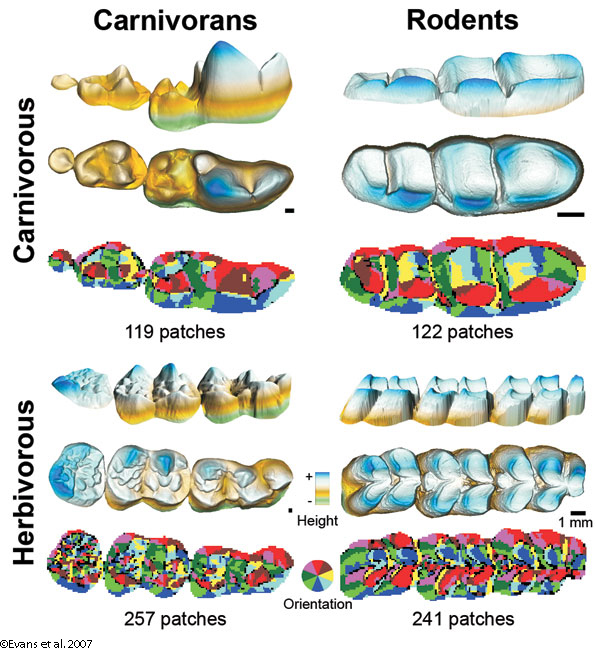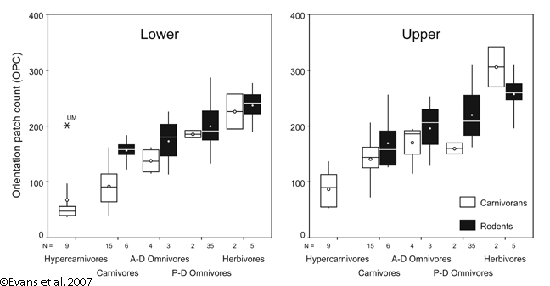Many studies quantifying tooth shape use 2-D information to represent complex, 3-D teeth. Some also rely upon homologous landmarks, which do not permit comparisons of vastly different tooth shapes.
Tooth surface ‘complexity’
Using a high-resolution 3-D laser scanner and Geographic Information Systems (GIS) analyses, we are developing methods to address these limitations. On digital elevation models of a tooth surfaces, we map the cardinal orientation of each pixel. Patches of continguous pixels of the same orientation sum to theOrientation Patch Count (OPC), which provides a measure of ‘dental complexity.’
In two disparate mammalian orders,carnivorans and rodents, we found that OPC values positively correlate with diet, from faunivores to omnivores to herbivores, and the OPC ranges for each dietary category are similar across orders. Thus, OPC is an emergent property of otherwise vastly different orders. As a measure of the number of ‘tools’ on a tooth, it reflects the mechanical processing needed to efficiently breakdown food items (Evans et al. 2007).

Inferring diet in extinct taxa
The Multituberculata, sometimes called ‘the rodents of the Mesozoic,’ were an extraordinarily successful group of non-therian mammals that went extinct at the end of the Eocene. Despite a highly suggestive dental complex consisting of procumbent incisors, blade-like premolars, grinding molars with multiple rows of cusps, and backward chewing motion of multituberculates, it remains unclear what these mammals ate. Hypotheses range from carnivory to omnivory to herbivory and even specialized egg-eaters.
 |
 |
 |
 |
|
Digital elevation models and orientation patch maps of lower cheek tooth rows of the latest Cretaceous Meniscoessus robustus (L) and early Paleocene Taeniolabis taoensis (R). |
|||
Our preliminary results show that OPC values and presumably breadth of dietary specializations increase over geologic time, from mainly insectivory to omnivory and herbivory (Wilson et al. 2006, in prep.). These methods hold promise for examining morphological diversity of mammalian paleocommunities and taxonomic groups through time and across geographic regions for comparisons with patterns of taxonomic diversity.
Collaborators: Jukka Jernvall, Alistair Evans, Mikael Fortelius
Funding: NSF Postdoctoral Fellowship, UW Royalty Research Fund
Press coverage: Science Daily, Nature Podcast
Publications: Evans, A., G.P. Wilson, M. Fortelius, and J. Jernvall. 2007. High-level similarity in dentitions of carnivorans and rodents. Nature 445:78-81.
